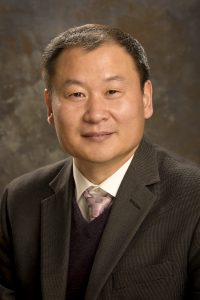New Faculty Profile: Wei Guo

Where did you grow up?
I grew up in a small town located in Henan province, China.
What is your educational/professional background?
I received both my B.S. in molecular and cellular biology and my Ph.D. in animal science from China Agricultural University. I did my postdoctoral training in the Departments of Animal Sciences, Nutritional Science and Cell and Regenerative Biology at UW–Madison. Before coming back to UW–Madison, I was an associate professor at University of Wyoming.
How did you get into your field of research?
I started to get into my research field when I conducted my Ph.D. research project, which is closely related to my current research program.
What is the main goal of your current research program?
The main goal is to understand fundamental mechanisms of muscle growth, development, regeneration and diseases, as well as life course impact of developmental programming on muscle function. Another major goal is to discover new bioactive molecules from animal co-products and add value to animal co-products to benefit the animal industry and human health.
What attracted you to UW-Madison?
This is an excellent university with excellent research environment and a long and rich history of the Wisconsin Idea. Plus, Madison is a beautiful city, with its isthmus location between Lake Mendota and Lake Monona.
What was your first visit to campus like?
I pretty much enjoyed my first visit. Particularly, the Badger statues are very impressive.
What’s one thing you hope students who take a class with you will come away with?
I hope the students who take my class will come away with active learning skills.
Do you feel your work relates in any way to the Wisconsin Idea? If so, please describe how.
Yes. Meat is a major source of protein for human consumption. However, current meat production will not be able to meet the increasing needs of a growing population world-wide. Alternative ways to provide sufficient protein sources for human consumption can be developed with the Wisconsin Idea.
What’s something interesting about your area of expertise you can share that will make us sound smarter at parties?
In the extreme sport of bungee jumping, when people jump and free-fall from a great height, the bungee cord, like a rubber band or spring, is stretched from a relaxed position to generate passive force to absorb the energy from the descent. Thus, the elastic bungee cord saves the jumper a lot of internal damage and psychological trauma. Amazingly, nature also employs elasticity to dampen biological forces or generate passive stiffness at the molecular level, such as muscle stretching during exercise. The molecular bungee cord that serves this purpose in the human or animal muscle fiber is a protein named “titin,” which is the largest protein identified so far in vertebrate animals.
What are your hobbies/other interests?
I enjoy playing basketball, hiking, skiing and watching Badger football and basketball games.
